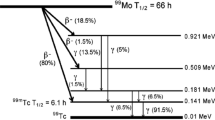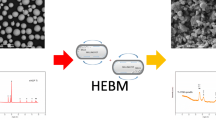Abstract
Identifying both physical and chemical characteristics of Special Nuclear Material (SNM) production processes is the corner stone of nuclear forensics. Typically, processing markers are based on measuring an interdicted sample’s bulk chemical properties, such as the elemental or isotopic composition, or focusing on the chemical and physical morphology of only a few particles. Therefore, it is imperative that known SNM processes be fully characterized from bulk to trace level for each particle size range. This report outlines a series of particle size measurements and fractionation techniques that can be applied to a bulk SNM powders, categorizing both chemical and physical properties in discrete particle size fractions. This will be demonstrated by characterizing the process signatures of a series of different depleted uranium oxides prepared at increasing firing temperatures (350–1100 °C). Results will demonstrate how each oxides’ material density, particle size distribution, and morphology varies.
Similar content being viewed by others
References
R. H. Condit, UCRL-ID-114164, 1993.
M. J. Kleeman, J. J. Schauer, G. R. Cass, Environ. Sci. Technol., 33 (1999) 3516.
A. G. Allen, E. Nemitz, J. P. Shi, R. M. Harrison, J. C. Greenwood, Atmos. Environ., 35 (2001) 4581.
V. A. Kashparov, Y. A. Ivanov, S. I. Zvarisch, V. P. Protsak, Y. V. Khomutinin, A. D. Kurepin, E. M. Pazukhin, Nucl. Technol., 114 (1996) 246.
B. Salbu, T. Krekling, O. C. Lind, D. H. Oughton, M. Drakopoulos, A. Simionovici, I. Snigireva, A. Snigirev, T. Weitkamp, F. Adams, K. Janssens, V. A. Kashparov, Nucl. Instr. Meth. Phys. Res., A467–468 (2001) 1249.
B. Salbu, K. Jannssens, O. C. Lind, K. Proost, P. R. Danesi, J. Environ. Radioact., 64 (2003) 167.
X. Machuron-Mandard, C. Madic, J. Alloys Comp., 235 (1996) 216.
V. A. Marple, K. L. Rubow, S. M. Behm, Aerosol Sci. Technol., 14 (1991) 434.
MSP Corporation, SOP.
M. Benedict, T. H. Pigford, H. W. Levi, Nuclear Chemical Engineering, 2nd ed., McGraw-Hill, Inc., New York, 1981, p. 224.
E. H. P. Cordfunke, A. A. Van Der Giessen, J. Nucl. Mater., 24 (1967) 141.
W. C. Hinds, Aerosol Technology: Properties, Behavior, and Measurement of Airborne Particles, John Wiley & Sons, Inc., New York, 1999.
T. C. Miller, H. L. Dewitt, G. J. Havrilla, Spectrochim. Acta, B60 (2005) 1458.
Author information
Authors and Affiliations
Corresponding author
Rights and permissions
About this article
Cite this article
Hastings, E.P., Lewis, C., FitzPatrick, J. et al. Characterization of depleted uranium oxides fabricated using different processing methods. J Radioanal Nucl Chem 276, 475–481 (2008). https://doi.org/10.1007/s10967-008-0529-6
Received:
Published:
Issue Date:
DOI: https://doi.org/10.1007/s10967-008-0529-6




